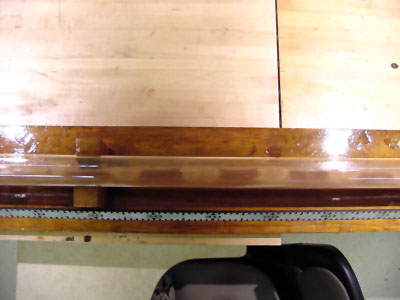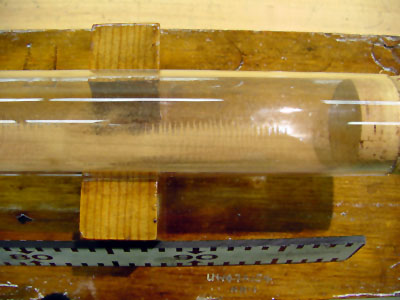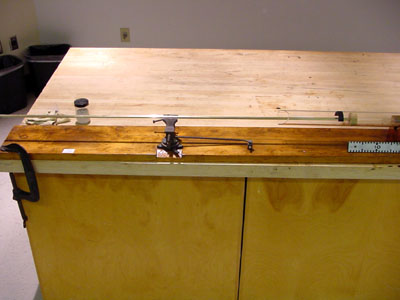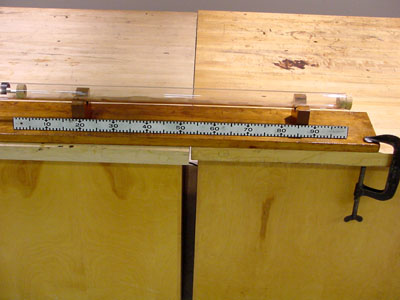Kundt's Tube, 3D30.60
pira200 Listed
Location:
Cabinet: Waves & Sound (WS)
Bay: (A3 to A5)
Shelf: "T"
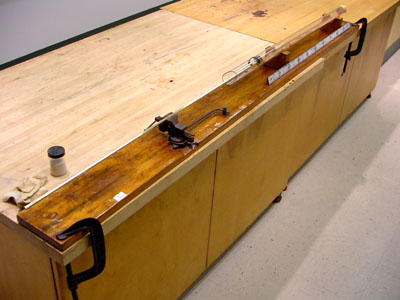
Description:
The Kundt's tube can be used to find the velocity of sound waves in a solid brass rod. It also is an excellent way to show standing waves in a pipe. The brass rod, which is fixed at its center, vibrates at its natural frequency when rubbed with a rosined cloth. The cork diaphragm at the end of the rod then excites the air molecules in the glass tube. By adjusting the tube, standing waves are produced which disturbs some cork dust that is sprinkled along the length of the tube. The cork dust then piles up at the displacement nodes which are separated by a distance of λ/2. From this measurement, the frequency of the sound waves can be determined. Since the rod is fixed at its center, its length represents λ'/2 where λ' is the wavelength of sound in the rod. Knowing the frequency (from the standing waves in air) and the wavelength λ' in the rod, the velocity ν' = fλ' can be found.
Equipment |
Location |
ID Number |
|
|
|
Kundt's Tube |
(WS) A3 to A5, Shelf "T" |
5D30.60 |
Chamois or soft cloth |
|
|
Rosin Powder |
|
|
2 Large C-clamps |
Rod and Stand Cabinet |
|
Meterstick |
In Lecture Halls |
|
Extra Cork Dust |
Stock Cabinet |
|
Extra Rosin Powder |
Stock Cabinet |
|
Setup:
- For visibility, position a ceiling or external camera to observe the standing waves that form in the tube.
- Clamp the base of the apparatus to the lab bench so it doesn't move when the rod is being rubbed.
- Check that there is enough cork dust in the tube if not add some from stock.
- Slide glass tube out and gently shake it back and forth so the cork dust is evenly distributed along its length of tube.
- Make absolutely sure that the cork diaphragm at the end of the brass rod is NOT touching the inner walls of the glass tube - the rod will not resonate if the diaphragm is in contact with the tube.
- The tube may need to be adjusted, moved back-and-forth to reach resonance.
Cautions, Warnings, or Safety Concerns:
- Brass rod can bend popping the glass tube off it's supports.
- Demonstration may require practice.
- Resin powder will/can build up on the rod due to the heat from rubbing the rod.
Demonstration:
Shake some resin powder on the Chamois or soft cloth and rub the first 6" to 10" of the end of the brass rod. When rubbing use short pulling or pushing strokes with a good amount of pressure. If the cork diaphragm at the end of the brass rod is NOT touching the inner walls of the glass tube, the rod should start to sing. You will want to practice this before class to master your technique.
While rubbing, have a volunteer from the class slide the glass tube back-and-forth until resonance occurs and the cork dust starts piling up at the nodes. Measure the distance between the piles of cork dust to give λ/2. Since v in air about 33100 cm/sec, the frequency can be determined by using f = ν/λ. Finally, since the length of the brass rod is 4 feet or 122 cm, we can calculate the value of λ'/2 in brass. Why? The fixed point of the rod forces a node in the center, and the free ends are antinodes.
|
|
|
|
References:
